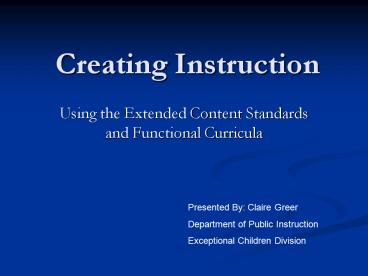Creating Instruction - PowerPoint PPT Presentation
1 / 29
Title: Creating Instruction
1
Creating Instruction
- Using the Extended Content Standards and
Functional Curricula
Presented By Claire Greer Department of Public
Instruction Exceptional Children Division
2
What Do We Teach?
- Students with the most significant cognitive
disabilities should - receive instruction on grade level content
standards (may be at a lower complexity level)
within the context of grade level curriculum
ensuring that the intent of the grade level
content standard remains intact - use the same or similar materials, or adapted
version of the materials, and appropriate
assistive technology to gain access
3
Call of the Wild
- Written By Jack London
- Adapted By Jocelyn Watson-Garland and Amber
Harris http//education.uncc.edu/access/apaptedboo
ks.htm - Adapted further by Claire Greer, Department of
Public Instruction, Exceptional Childrens
Division
4
Adapted version of the same material
5
(No Transcript)
6
Balance of Academic and Functional
- Students with the most significant cognitive
disabilities should - be taught skills that will enhance their
independence in the next critical environment - Some of those skills must be embedded in natural
routines and in socially valid contexts - be taught academic content
7
Students with the most significant cognitive
disabilities should
- not have to wait until they are able to make a
bed before they are taught to read or identify
initial letter sounds before they are taught
literature - be presumed competent and not denied instruction
offered to students of the same age (grade level
content standards and curriculum)
8
Is it Reading? Is it Math? Is it Science?
- Diane Browder in her book Aligning IEPs to
Academic Standards addresses the issue of, Is
it Reading? - Which means, Is the student actually learning a
reading skill or is it something else? - Lets decide
9
English/Language Arts Grade 7 Competency Goal 5
- Grade level
- The learner will respond to various literary
genres using interpretative and evaluative
processes. - Extension
- The learner will explore and respond to a variety
of print and non-print texts (functional and
literary) - Explore and/or analyze relationships of
characters, ideas, concepts (including literary
devices) and/or experiences - Extend understanding by creating products that
exemplify specific types of text.
10
Is it Reading?
- John will make a presentation to the class on
Call of the Wild using a single switch voice
output device - Is it Reading? No, John is activating a single
switch which is presented to him and then
withdrawn. - Does it link to the grade level content standard
on exploring and responding to a variety of print
and non-print texts? Yes. Although the
presentation tells the class about the book it is
very weak link because it does not show what John
has learned about the book. There is no choice
involved. - Is it meaningful? Making a presentation is
something all middle school students are expected
to do, and it is important to work on this skill.
John does a great job, but it is not reading.
But it could be a skill targeted for the IEP.
11
Lets Try Again
- John will identify concepts dealing with home and
family. - Is this Reading? Yes. John is gaining information
from the cues symbolic of the concepts, and
demonstrating comprehension by selecting the
correct cue. - Does it link to the grade level content standard
on exploring and responding to a variety of print
and non-print texts? Yes. John is reviewing the
same concepts as all students The learner will
identify ideas related to home and family. - Is it Meaningful? John is learning what has been
identified as important for all students to know
and home and family are personally relevant
topics.
12
Creating a Unit
- Unit
- Whale Rider
- 3 students
- 3 access points Symbolic, Early Symbolic,
Pre-symbolic - 2 grades
13
Introducing Our Students
- Shyniqua- Symbolic, 6th Grade
- Label of Mental Disablity
- I.Q. of 59
- Has some word recognition skills Kindergarten
level - Verbal
- Difficulty with comprehension and creating text
independently - Good fine and gross motor skills
14
- Jonathan- Early Symbolic- 6th Grade
- Label of Mental Disability
- I.Q. of 40
- Non-ambulatory and fine motor difficulties
- Low vision abilities
- Some verbal ability but not able to communicate
many basic wants and needs - Does not appear able to read
15
- Kelly- Pre-symbolic- 7th Grade
- Label of autism and mental disability
- I.Q. below 30
- Seizures and sensory impairments
- Fine and gross motor skill deficits
- No conventional communication
- Runs away and sometimes hits
- Does not appear able to read
16
Our Dilemma
- What should their educational program look like?
- Academics?
- Frequent opportunities?
- Functional skills?
- Separate classroom?
- Part time in general education?
- Full time inclusion?
17
Our Dilemma
- How do we support their communication?
- Content vocabulary?
- Functional words?
- Sign language?
- Low tech or high tech?
18
Unit on Whale Rider
- Whale Rider by Witi Ihimaera
19
(No Transcript)
20
(No Transcript)
21
(No Transcript)
22
(No Transcript)
23
(No Transcript)
24
Science Unit
- Weather
- Children for this unit are in 2nd grade
- and functioning at all three access levels
25
(No Transcript)
26
(No Transcript)
27
(No Transcript)
28
(No Transcript)
29
Standards Based Unit of Study
- Things to consider when creating a unit
- What do I want the students to know and be able
to do at the end of the unit? (based on academic
extension) Essential skill(s) - What functional skills can be embedded into the
unit? - What instructional strategies and activities
should be presented? - What assistive technology will be needed to
access lessons and or functional outcomes?































